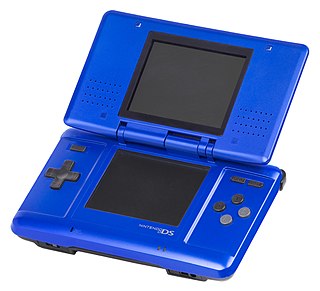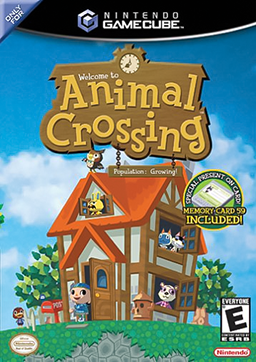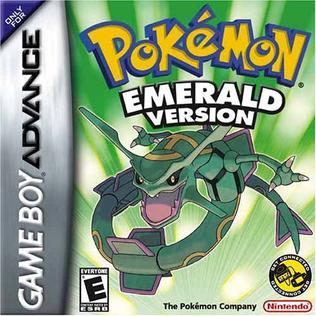
The Game Boy Advance (GBA) is a 32-bit handheld game console developed, manufactured and marketed by Nintendo as the successor to the Game Boy Color. It was released in Japan on March 21, 2001, in North America on June 11, 2001, in the PAL region on June 22, 2001, and in mainland China as iQue Game Boy Advance on June 8, 2004. The GBA is part of the sixth generation of video game consoles. The original model was followed in 2003 by the Game Boy Advance SP, a redesigned model with a frontlit screen and clamshell form factor. A newer revision of the SP with a backlit screen was released in 2005. A miniaturized redesign, the Game Boy Micro, was released in September 2005.

Pokémon Ruby Version and Pokémon Sapphire Version are 2002 role-playing video games developed by Game Freak, published by The Pokémon Company and Nintendo for the Game Boy Advance. They are the first installments in the third generation of the Pokémon video game series, also known as the "advanced generation". After years of Nintendo being the sole publisher of the franchise in all regions, The Pokémon Company co-published the games for the first time since the establishment of the joint-owned company in 1998. They were first released in Japan in late 2002, and internationally in 2003. Pokémon Emerald, a third version, was released two years later in each region. Remakes of the two games, titled Pokémon Omega Ruby and Alpha Sapphire, were released for the Nintendo 3DS worldwide in November 2014, exactly twelve years to the date of the original Ruby and Sapphire release date, with the exception of Europe, where it released a week later.

Pokémon Colosseum is a role-playing video game in the Pokémon series developed by Genius Sonority, published by The Pokémon Company, and distributed by Nintendo. It was released for the GameCube on November 21, 2003, in Japan; March 22, 2004, in North America; and May 14, 2004, in Europe. Unlike previous titles' random encounters with Pokémon, Colosseum allows the player to steal ("snag") the Pokémon of other Pokémon Trainers. The game also features single-player and multiplayer battle modes.

Pokémon FireRed Version and Pokémon LeafGreen Version are 2004 remakes of the 1996 Game Boy role-playing video games Pokémon Red and Blue. They were developed by Game Freak, published by The Pokémon Company and Nintendo for the Game Boy Advance. FireRed and LeafGreen were first released in Japan in January 2004 and in North America and Europe in September and October 2004 respectively. The games are part of the third generation of the Pokémon video game series and hold the distinction of being the first enhanced remakes of previous games within the franchise.

The Game Boy Player (DOL-017) is a GameCube peripheral developed by Nintendo which enables it to play Game Boy, Game Boy Color, and Game Boy Advance cartridges, allowing those games to be played on a television.

The Nintendo DS is a handheld game console produced by Nintendo, released globally across 2004 and 2005. The DS, an initialism for "Developers' System" or "Dual Screen", introduced distinctive new features to handheld games: two LCD screens working in tandem, a built-in microphone and support for wireless connectivity. Both screens are encompassed within a clamshell design similar to the Game Boy Advance SP. The Nintendo DS also features the ability for multiple DS consoles to directly interact with each other over Wi-Fi within a short range without the need to connect to an existing wireless network. Alternatively, they could interact online using the now-defunct Nintendo Wi-Fi Connection service. Its main competitor was Sony's PlayStation Portable during the seventh generation of video game consoles.

Sonic Advance is a 2001 platform game developed by Dimps for the Game Boy Advance (GBA). It was the first Sonic the Hedgehog game released on a Nintendo console with Sonic Adventure 2: Battle on the GameCube, and was produced in commemoration of the series' tenth anniversary. The story follows Sonic, Tails, Knuckles, and Amy as they journey to stop Doctor Eggman from taking over the world. Controlling a character, players are tasked with completing each level, defeating Eggman and his robot army, and collecting the seven Chaos Emeralds.

Animal Crossing, known in Japan as Dōbutsu no Mori+, is a 2001 social simulation game developed and published by Nintendo for the GameCube. As such, it is the first game in the Animal Crossing series, and is also an enhanced version of the Nintendo 64 game Dōbutsu no Mori, which was only released in Japan earlier the same year, and was followed by another edition, Dōbutsu no Mori e+, in 2003.

Pokémon Emerald Version is a 2004 role-playing video game developed by Game Freak, published by The Pokémon Company and Nintendo for the Game Boy Advance. It was first released in Japan in 2004, and was later released internationally in 2005. It is a third version after Pokémon Ruby and Sapphire and is the final game of the third generation of the Pokémon video game series.

Pokémon Pinball: Ruby & Sapphire is a 2003 pinball game developed by Jupiter, published by The Pokémon Company and distributed by Nintendo for the Game Boy Advance handheld game console. It was first revealed at E3 2003. The North American release was done to coincide with the fifth anniversary of the North American release of Pokémon Red and Blue. It is based on Pokémon Ruby and Sapphire, and is a sequel to Pokémon Pinball for the Game Boy Color. In some ways, it plays like a traditional pinball game, where the objective is to get a high score by keeping the ball in play as long as possible and hitting bumpers. In keeping with the theme of Pokémon, it features Pokémon collection, where while the players play pinball, they must also capture the eponymous creatures.

The GameCube Game Boy Advance cable (DOL-011) is a cable used to connect the Game Boy Advance (GBA) to the GameCube (GCN). Depending on the games, the cable may facilitate unlocking additional content, turning the GBA into a second screen, turning the GBA into a separate controller, or transferring in-game items between related games.

Pokémon is a series of video games developed by Game Freak and published by Nintendo and The Pokémon Company under the Pokémon media franchise. It was created by Satoshi Tajiri with assistance from Ken Sugimori, the first games, Pocket Monsters Red and Green, were released in 1996 in Japan for the Game Boy, later released outside of Japan as Pokémon Red and Blue. The main series of role-playing video games (RPGs), referred as the "core series" by their developers, have continued on each generation of Nintendo's handhelds. The most recently released core series game, Pokémon Scarlet and Violet, was released on November 18, 2022, for the Nintendo Switch.
The Virtual Console was a line of downloadable video games for Nintendo's Wii and Wii U home video game consoles and the Nintendo 3DS family of systems.

The Game Boy Advance Wireless Adapter is a wireless adapter accessory for the Game Boy Advance, released by Nintendo in 2004. It provides an alternative to the Game Boy Advance Game Link Cable but is only supported by a small number of games. The Game Boy Advance Wireless Adapter is also compatible with the Game Boy Advance SP, Game Boy Player, and e-Reader.

The Nintendo Game Link Cable is an accessory for the Game Boy line of handheld video game systems, allowing players to connect Game Boys of all types for multiplayer gaming. Depending on the games, a Game Link Cable can be used to link two games of the same title, like Tetris, or two compatible games like Pokémon Red and Blue. Games can be linked for head-to-head competition, cooperative play, trading items, unlocking hidden features, etc.
This is a list of video game accessories that have been released for the Game Boy handheld console and its successors. Accessories add functionality that the console would otherwise not have.
GameCube accessories include first-party releases from Nintendo, and third-party devices, since the GameCube's launch in 2001.
















